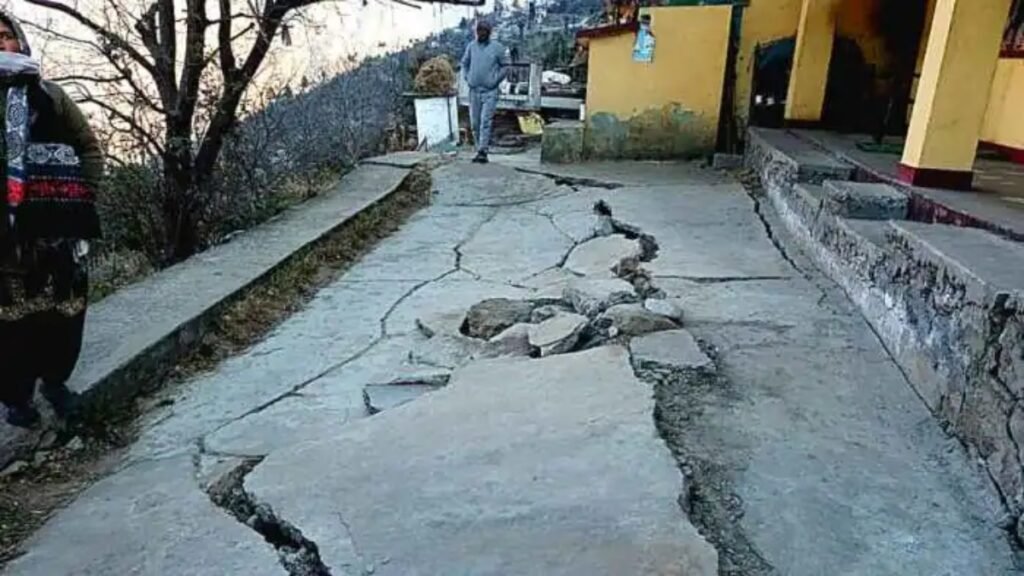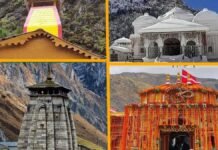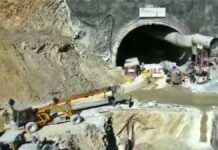
Dehradun: In the report of a three-member expert committee of Sridev Suman Uttarakhand University, the puncture (hole) in the aquifer (aquifer) due to tunneling for NTPC’s Tapovan Vishnugad project has been considered as a major reason for the landslide in Joshimath. However, the committee also claims that the geological structure of Joshimath and construction beyond its load-bearing capacity also led to the landslide. The committee has suggested reducing the load capacity of Joshimath in the present circumstances. The University will hand over the study report of the committee to the Governor, Governance, and Disaster Management Department.
Sridev Suman Uttarakhand University constituted a three-member committee to study the causes of landslides in Joshimath. In the committee, the Dean of the Faculty of Arts and the Chairman of the Department of Geography, Prof. DC Goswami, Dr. Srikrishna Nautiyal, Department of Geography, and Dr. Arvind Bhatt, Head, Department of Geography, Gopeshwar Campus. The committee prepared its report after studying the landslide in Joshimath from January 25 to January 28.
On Monday, the chairman of the committee, Prof. DC Goswami submitted the study report to the Vice Chancellor. Pro. DC Goswami told reporters that looking at the geological structure of Joshimath, it was covered by glaciers for a long time. The surface of Joshimath was formed from the debris of the glacier and large boulders. He said that the surface of Joshimath and the slope of the boulders are on the same side.
Told that the aquifer got punctured during the tunneling of NTPC, due to which the water sources leading to the village were also affected. He said that 580 liters per minute groundwater leakage near Jaypee Project is proof of this. Committee member Dr. Shrikrishna Nautiyal told that according to the load-bearing capacity of Joshimath, buildings of a height of more than 25 meters were not to be constructed. While seven-story buildings were constructed in the area. He said that all three are due to landslides in Joshimath. He said that to reduce the load capacity of Joshimath, demolition, and re-establishment of buildings is the only solution at present.
The operation of Chardham Yatra will not affect the stoppage
Committee member Dr. Shri Krishna Nautiyal said that no problem will arise in the operation of the Chardham Yatra from Joshimath. He said that the load on the area will increase due to the stay of people in Joshimath. If the Chardham Yatris leave directly, then there will be no significant impact on the area.
Preparation will have to be done for the challenges of a disaster like Joshimath
The committee studying landslides in Joshimath says that Uttarakhand is in earthquake-sensitive zone five. The state will have to be prepared for disasters like Joshimath and Turkey. The government needs to create air relief centers and land banks for displacement to provide relief to the disaster-hit areas. For monitoring the construction, there should be strictness regarding the formation of authority at the block level and geological survey before the construction of plans.

Chairman of the study committee of Shri Dev Suman Uttarakhand University, Prof. DC Goswami told reporters that the Joshimath disaster is a lesson. Roads are closed during disasters. That’s why the government should set up air relief centers in airports and districts to start relief work immediately in disaster-hit areas. Dry fruits, processed fruits, tarpaulins, water, and essential resources should be stored in these centers. Told that the government will have to start work on creating a land bank in every district for the rehabilitation of the disaster affected.
Pro. DC Goswami said that even the building code is not strictly followed. For this, there is a need to set up development authorities at the block level. Said that before starting any major project in any state, according to the current situation, it is necessary to conduct geological survey along with expert agency investigation of the concerned area.
Crown shaped cracks
Committee member Dr. Shrikrishna Nautiyal said that cracks are coming in the shape of the crown in Joshimath. The depth of about half a kilometer long cracks is about 60 meters. The most affected is ward number 9 (Manohar Bagh). It is said that 100 to 150 houses are under the threat of landslide. The cracks here are 500 meters long and 2 feet wide. He told that the first pillar of the ropeway starts from here. These cracks are being filled with soil and polythene is being used but the cracks are re-emerging from the surrounding.
Diploma and degree courses will be started
Shri Dev Suman Uttarakhand University’s Assistant Controller of Examinations Hemant Bisht said that the university should start degree and diploma courses on disaster management. On this, Examination Controller Khemraj Bisht said that the university has designed diploma and certificate courses on disaster management. On the other hand, Dr. Anita Rana Rawat, director of the Institute of Higher Education (YUSC), said that these courses should be open and free from the compulsion of age and faculty. Vice Chancellor Prof. Accepting his suggestion, MS Rawat also sought his cooperation.





















































